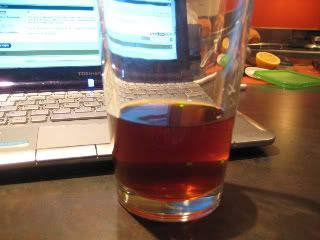bierhaus15
Well-Known Member
- Joined
- Aug 4, 2008
- Messages
- 1,951
- Reaction score
- 452
Well I just finished another long brew session today, a simple special bitter that used 10% of my homemade no.1 brewers invert syrup and was pitched with some top cropped wy1318 (great to see more people using it!). The beer should turn out pretty good, though it's more of a test batch than anything else. However, we got 18 inches of snow last night, so it wasn't too fun standing outside the apartment in the cold and snow for hours...
And like a moron, I decided yesterday that I would brew on Tuesday too. Made a starter of wy1968 last night so it looks like I'm back out in the cold tomorrow. Still don't know what I'll be brewing - I'm pretty much burned out on bitters, I got 2 fermenting, 3 on tap, and another batch in mini kegs. I'm thinking about either doing a brown ale of sorts or maybe even a robust porter. I have the real recipe for Smuttynose Porter which is superb, though I've never used wy1968 for it. Ah, what to do... suggestions?
And like a moron, I decided yesterday that I would brew on Tuesday too. Made a starter of wy1968 last night so it looks like I'm back out in the cold tomorrow. Still don't know what I'll be brewing - I'm pretty much burned out on bitters, I got 2 fermenting, 3 on tap, and another batch in mini kegs. I'm thinking about either doing a brown ale of sorts or maybe even a robust porter. I have the real recipe for Smuttynose Porter which is superb, though I've never used wy1968 for it. Ah, what to do... suggestions?








![Craft A Brew - Safale BE-256 Yeast - Fermentis - Belgian Ale Dry Yeast - For Belgian & Strong Ales - Ingredients for Home Brewing - Beer Making Supplies - [3 Pack]](https://m.media-amazon.com/images/I/51bcKEwQmWL._SL500_.jpg)


















































